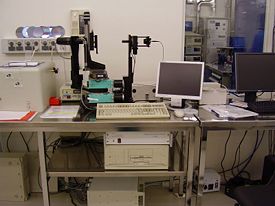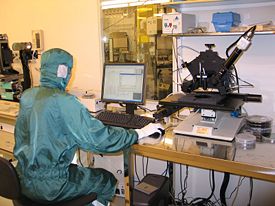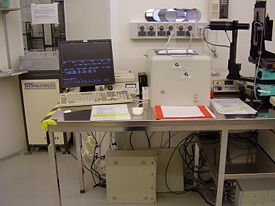Specific Process Knowledge/Characterization/Optical characterization
Ellipsometer

This ellipsometer is a VASE (Variable Angle Spectroscopic Ellipsometry) ellipsometer from J.A. Woollam Co., Inc.
Ellipsometry is a very sensitive characterization technique which can be used to determine thin film layer thicknesses and/or optical constants. It sends in polarized light on the surface at different angles and measures the change in polarization state of the reflected light.
It is especially good for thin films in the thickness range of a few nanometers to a few microns. The layer should be transparent to light in the usable wavelength range for the thickness to be determined. Large roughness (>40nm) and features within the field of view can cause the measurement to fail.
Ellipsometry is an indirect measurement so a model has to be fit to the data in order to obtain the film thickness and optical constants.
A rough overview of the performance of the Ellipsometer
| Purpose | Film thickness measurements and optical characterization of optically transparent thin films |
|
|---|---|---|
| Performance | Thin film materials that can be measured |
Any film that is transparent to the light in the given wavelength range ex:
|
| . | Film thickness range |
|
| Process parameter range | Wavelength range |
|
| Substrates | Batch size |
|
| . | Substrate material allowed |
|
Filmtek 4000

FilmTek 4000 is a computerized film thickness measurement and material characterization system. This system combines fiber-optic spectrophotometry with advanced material modeling software to provide an affordable and reliable tool for the simultaneous measurement of film thickness, index of refraction, and extinction coefficient
Normal incidence and polarized 70 degree reflection data is collected and used to calculate thickness and index of refraction of the measured film using SCI’s patented Differential Power Spectral Density (DPSD) technique. Absolute reflection data is obtained by comparing sample data to the measured reflection of a known reference sample, typically a silicon wafer with a thermally grown thin oxide (~63 nm) film.
The spectrophotometer scans the sample over a predefined range of wavelengths. The software generates a reflection spectrum based on a previously stored reference scan, and then performs a regression on the unknown parameters to fit the simulated reflection and power spectral density to the observed values. The resulting thin film parameters along with the measured and modeled spectra are then displayed for the user to examine.
A rough overview of the performance of the FilmTek
| Purpose | Film thickness measurements and optical characterization of optically transparent thin films |
|
|---|---|---|
| Performance | Thin film materials that can be measured |
Any film that is transparent to the light in the given wavelength range ex:
|
| . | Film thickness range |
|
| Process parameter range | Wavelength range |
|
| Substrates | Batch size |
|
| . | Substrate material allowed |
|
Prism Coupler


The sample to be measured see above is brought into contact with the base of a prism by means of a pneumatically-operated coupling head, creating a small air gap between the film and the prism. A laser beam strikes the base of the prism and is normally totally reflected at the prism base onto a photodetector. At certain discrete values of the incident angle , called mode angles, photons can tunnel across the air gap into the film and enter into a guided optical propagation mode, causing a sharp drop in the intensity of light reaching the detector.
To a rough approximation, the angular location of the first mode determines film index, while the angular difference between the modes determines the thickness, allowing thickness and index to be measured completely independently.
Measurements are made using a computer-driven rotary table which varies the incident angle , and locates each of the film propagation modes. As soon as two of the mode angles are found, film thickness and index can be calculated. The entire measurement process is fully automated and requires approximately twenty seconds.
The number of modes supported by a film of given index increases with film thickness. For most film/substrate combinations, a thickness of 1000-2000 Å is required to support the first mode, while films in the one-micron range can support as many as four or five modes. If the film is thick enough to support two or more propagation modes (typically 3000- 4800 Å), the Prism coupler calculates thickness and index for each pair of modes, and displays the average and standard deviation of these multiple estimates.
The standard deviation calculation, unique to the prism coupling technique, is an indication of measurement self-consistency and a powerful means of confirming the validity of the measurement.
Comparison of the three methods
For comparison of the three methods, see here: Film thickness and optical constants of optical transparent films
